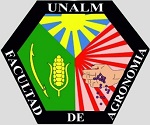Cultural, biological and chemical control of the white rot fungus (Sclerotium cepivorum, Berk) in onions (Allium cepa) in Arequipa´s countryside
DOI:
https://doi.org/10.21704/pja.v2i3.1230Palabras clave:
Biocontrol agent, sclerotia, incidence, severity, pathogenResumen
This experiment was carried out at the province of Arequipa, to determine broccoli residual effects on the sclerotia population of Sclerotium cepivorum on the soil and determine the best fungicides and biocontrol agents on the biggest red onion production. In two field areas infected with Sclerotium cepivorum, soil samples were carried out to determine the number of sclerotia at the beginning and the end of the trial. One area received broccoli residues before treatment installation. The experiment had a laboratory and a field phase. The block design was used completely randomized (DBCA), using seven fungicide treatments (T1) control, Iprodione (T2), Thiabendazole (T3), Boscalid (T4), Carbendazim (T5), T harzianum (T6), Bacillus subtilis (T7). Both areas received the same treatments. The density of sclerotia in the soil was not significant between these areas. However, the addition of broccoli had lower percentages of incidence and severity and higher yields in all treatments. At the area that received broccoli, the Boscalid (T4) and the Iprodine (T2) fungicide were highlighted with 43.33 T/ha and 28.33 T/ha, respectively; the area without broccoli, the T4 with 38.33 T/ha and T2 with 25.56 T/ha. T5 (Carbendazim) had the lowest yield: 15.00 T/ha without broccoli and 19.58 T/ha with broccoli.Descargas
Referencias
Arenas, M.A. (1997). Biocontroladores de Sclerotium cepivorum, Berk. en cebolla cv. Roja Arequipeña. Thesis to opt for the degree of Ingeniero Agrónomo. Universidad Nacional de San Agustín Arequipa – Perú. 115 p.
Coley-Smith, J.R., Mitchell, C.M. & Sansford, C.E. (1990). Long-term survival of sclerotia of Sclerotium cepivorum and Stromatinia gladioli. Plant Pathology, 39, 58-69. https://doi.org/10.1111/j.1365-3059.1990.tb02476.x
Obregón, M. (2001). Evaluación in vitro del poder antagónico de Trichoderma harzianum Rifai con respecto al hongo fitopatógeno Sclerotium cepivorum Berkeley causante de la enfermedad “Torbó en cebolla”. In: XLVII Reunión Anual del PCCMCA Resúmenes (19 p). San José, Costa Rica.
Oliveira, V.L., Belle, M., Menezes, J. & Ferreira, F. (1982). Ação antagônica de Trichoderma harzianum, Paecilomyces lilacinus e Penicillium sp. sobre Sclerotium cepivorum, causador da podridão branca do alho. Fitop. Bras., 7(3), 531.
Rosas, V., Ulacio, D., Jimenez, M., Perdomo, W. & Pardo, A. (2010). Análisis epidemiológico y control de Sclerotium cepivorum Berk. y la pudrición blanca en ajo. Bioagro, 22(3), 185-192. https://www.redalyc.org/html/857/85717010003/
Sistema integrado de estadística agrícola (SIEA), (2012). Indicadores productivos. Editorial OA-MINAG. Lima - Perú.
Schwartz, H.F. & Mohan, S. (2008). Compendium of onion and garlic disease. American Phytopathological Society (APS). St Paul, Minnesota. 127 p.
Utkhede, R.S. & Rahe, J.E. (1979). Wet sieving floatation technique for isolation of sclerotia of Sclerotium cepivorum from muck soil. Phytopathology 69:295-297.
Utkhede, R.S. & Rahe, J.E. (1983). Interactions of antagonist and pathogen in biological control of onion white rot. Phytopathology, 73, 890-893. DOI: 10.1094/Phyto-73-890.
Villar, A.C., Zavaleta, E. & Garcia, R. (1990). Efecto de la incorporación de residuos de crucíferas (Brassicae) sobre fitopatógenos de suelo. II Efecto de la incorporación de col y brócoli sobre la pudrición blanca (Sclerotium cepivorum Berk.) de la cebolla, bajo condiciones de invernadero. Revista Mexicana de Fitopatología, 8, 160-165.






